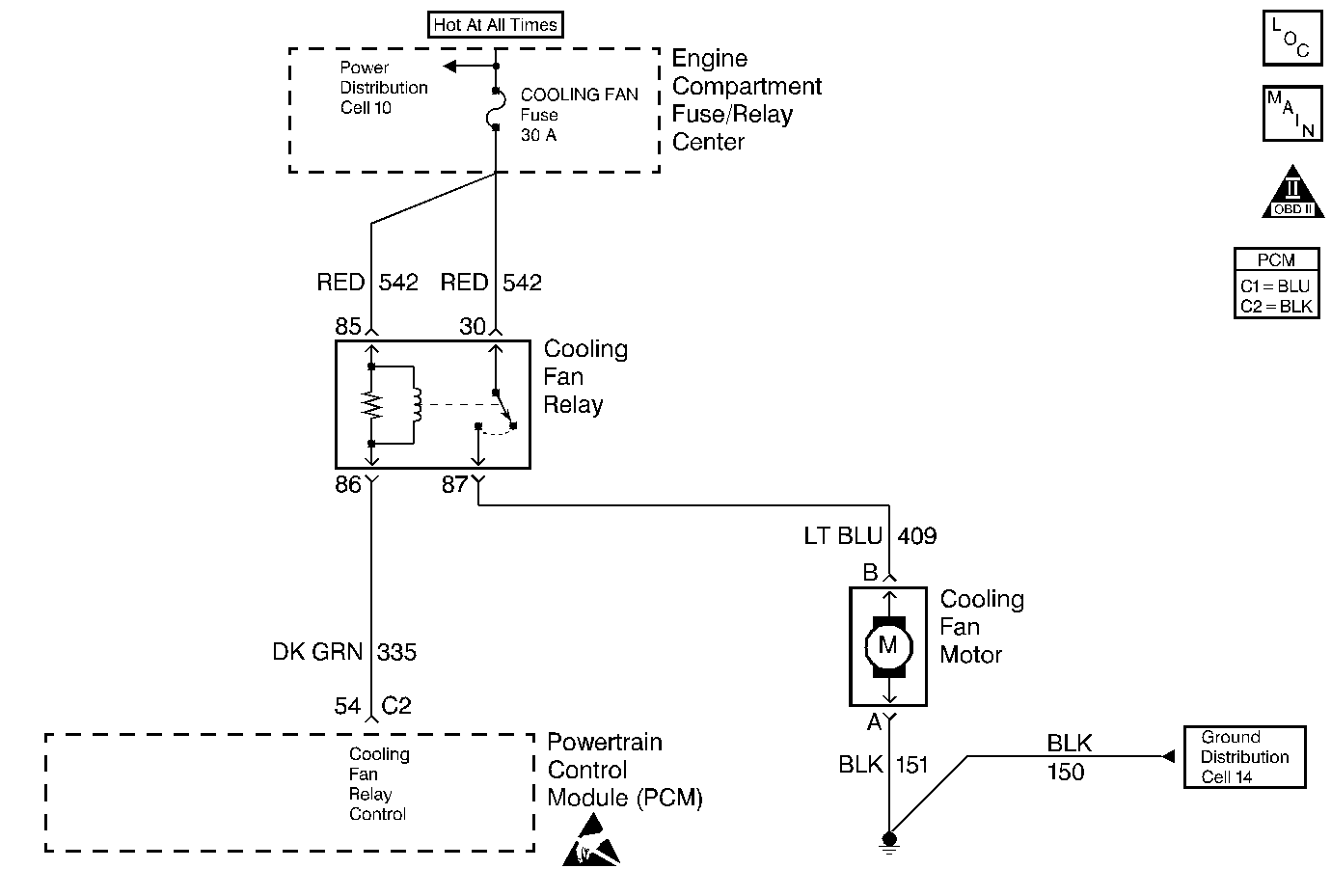
Circuit Description
The electric cooling fan is controlled by the powertrain control module (PCM) through the cooling fan relay based on inputs from the following components:
| • | The engine coolant temperature (ECT) sensor |
| • | The intake air temperature (IAT) sensor |
| • | The A/C selector switch |
| • | The A/C refrigerant pressure sensor |
| • | The vehicle speed sensor (VSS) |
The PCM controls the cooling fan by grounding the cooling fan control circuit which turns ON the cooling fan relay.
The cooling fan relay will be commanded ON when the following conditions are met:
| • | The engine coolant temperature reaches 106°C (223°F) or more. |
| • | The A/C clutch requested. |
| • | The vehicle speed is less than 38 MPH. |
The cooling fan relay will be commanded ON regardless of vehicle speed when the following conditions are met:
| • | A DTC is set that requests the coolant fan to be ON. |
| • | The engine coolant temperature is 151°C (304°F) or more. |
| • | The A/C refrigerant pressure is high. |
The cooling fan may be commanded ON when the engine is not running under a fan run-on conditions described in the electric cooling fan general description portion of the service manual.
Conditions for Setting the DTC
| • | Battery voltage is greater than 9.5 volts. |
| • | Coolant fan fault line detects a malfunction for 6 seconds. |
Action Taken When the DTC Sets
| • | The Malfunction Indicator Lamp (MIL) will illuminate. |
| • | The PCM will record operating conditions at the time the diagnostic fails. This information will be stored in the Freeze Frame and Failure Records buffers. |
| • | A history DTC is stored. |
Conditions for Clearing the MIL/DTC
| • | The MIL will turn OFF after three consecutive ignition cycles in which the diagnostic runs without a fault. |
| • | A history DTC will clear after 40 consecutive warm-up cycles without a fault. |
| • | The MIL/DTCs can be cleared by using the scan tool. |
Diagnostic Aids
| • | If the owner complained of an overheating problem, it must be determined if the complaint was due to an actual boil over, or if the Temp light, or temperature gage indicated overheating. |
| • | Check for the proper amount of coolant in the system. |
| • | If the gage, or light, indicates overheating, but no boil over is detected, the gage or light circuit should be checked. The gage accuracy can also be checked by comparing the engine coolant temperature sensor reading using a scan tool with the gage reading. |
| • | If the engine is actually overheating, and the gage indicates overheating, but the cooling fan is not coming ON, the Engine Coolant Temperature (ECT) sensor may have shifted out of calibration and should be checked. Refer to Temperature vs Resistance for a Temperature vs. Resistance table. |
| • | If the engine is overheating, and the coolant fan is ON, the cooling system should be checked. Refer to the cooling and radiator of the service manual. |
Test Description
The numbers below refer to the step numbers on the diagnostic table.
-
Listen for an audible click when the fan control relay operates. Be sure that both the ON and the OFF states are commanded. Repeat the commands as necessary.
-
This check can detect a partially shorted coil which would cause an excessive current flow. Allow the coil to warm up by leaving the circuit energized for 2 minutes. When the fan control relay is warm, the coil may open (Amps drop to 0), or short (goes above 0.75 amp).
-
It is important to identify and test the fan control relay coil terminals in order to avoid an improper diagnosis.
-
Reprogram the replacement PCM and perform the crankshaft position system variation learn procedure. Refer to PCM Replacement/Programming for PCM programming and CKP System Variation Learn Procedure for the Crankshaft Position System Variation Procedure.
Step | Action | Value(s) | Yes | No | ||||
|---|---|---|---|---|---|---|---|---|
1 | Did you perform the On-Board Diagnostic (OBD) System Check? | -- | Go to Powertrain On Board Diagnostic (OBD) System Check for 2.4L or Powertrain On Board Diagnostic (OBD) System Check for 2.2L | |||||
Does the fan control relay turn ON and OFF with each command? | -- | |||||||
Does the current draw a measure less than the specified value shown (but not 0)? | 0.75 A | Go to Diagnostic Aids | ||||||
4 |
Does the DMM display infinite resistance? | -- | ||||||
Does the test light turn ON and OFF with each command? | -- | |||||||
6 |
Does the test light illuminate? | -- | ||||||
7 |
Does the relay operate? | -- | ||||||
8 |
Was a problem found and corrected? | -- | ||||||
9 |
Was a problem found and corrected? | -- | ||||||
10 |
Is the repair complete? | -- | -- | |||||
11 |
Is the repair complete? | -- | -- | |||||
12 | Replace the malfunctioning fan control relay. Refer to A/C Compressor and Cooling Fan Relays Replacement . Is the action complete? | -- | -- | |||||
Replace the PCM. Refer to PCM Replacement . Is the action complete? | -- | -- | ||||||
14 |
Does the scan tool indicate that this test ran and passed? | -- | ||||||
15 | Check to see if any additional DTCs are set. Does the scan tool display any DTCs that you have not diagnosed? | -- | Go to the applicable DTC table | System OK |
